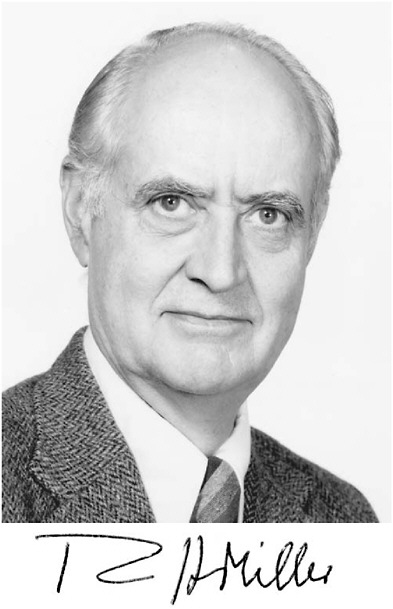RENE HARCOURT MILLER
1916–2003
Elected in 1968
“For aircraft engineering, especially helicopters, other vertical flight vehicles, and supersonic transports.”
BY JACK L. KERREBROCK
RENE HARCOURT MILLER died on January 28, 2003, at the age of 86. A consummate practicing aerospace engineer, Miller was also an enthusiastic educator dedicated to introducing young people to the joys of creation in aerospace engineering. Boundlessly enthusiastic, he transmitted his love of the process of creation of new aerospace systems to his students and to his peers.
Miller was born in Tenafly, New Jersey, in 1916, but attended grammar school and high school in France, where he lived with his mother and stepfather. He entered Cambridge University at 16 and received a B.A. in 1937 and an M.A. in 1956. Over his lifetime, he was successful in a wide range of increasingly responsible roles, beginning at the Glenn L. Martin Company and McDonnell Aircraft Corporation, where he participated in the design of some of the first jet-powered fighters for the U.S. Navy. He then did pioneering work on the design of helicopters at Kaman Aircraft, where, while on leave from the Massachusetts Institute of Technology (MIT), he became vice president of engineering.
When he returned to MIT, he dedicated himself to transmitting his knowledge and his attitudes to generations of students. He advanced through the academic ranks from assistant professor in 1944 to head of the Department of Aeronautics and Astronautics in 1968 and H.N. Slater Professor of Flight Transportation. Miller founded the MIT Flight Transportation Labora-
tory, which did research on the operations of the airline industry; for example, the laboratory undertook to determine optimum route structures and methodologies for setting airline ticket prices, although, at the time, both were set by government regulators. The laboratory and the work were unique in academia. Miller also conducted research on the aerodynamics and vibration of helicopter rotors and enthusiastically advocated the wider use of rotorcraft for short-haul transport.
In 1978, after a decade as department head, he returned to teaching, focusing on the development, with a colleague, James W. Mar, of a new academic organization, the MIT Space Systems Laboratory, which would introduce new generations of MIT students to the creative methodologies of design and the development of new artifacts for the exploration of space. At the time, such work was considered the exclusive province of mature professionals in large professional organizations. Miller and Mar made it possible for students in their early years, as undergraduates, to participate in such work. A key factor in their success was Miller’s enthusiasm and confidence in students’ abilities and his willingness to use his professional connections with highly placed people in government and the space industry on the students’ behalf. This laboratory has continued to evolve and still fulfills the role Miller envisioned for it.
In his professional work and his teaching, Miller always emphasized the engineering of complete systems for aeronautical and space activities. He always focused on the most important questions, rather than those that admitted of elegant research approaches. At the same time, Miller believed that every engineer, especially professors, should also be an expert in at least one specific discipline (e.g., aerodynamics, propulsion, structures, control, etc.). He espoused the engineering of complete systems to show the interrelation of aerodynamics, propulsion, structures, control, etc., in the design of aerospace vehicles, emphasizing that a design, even if created by the world’s best aerodynamicist, would not fulfill its function if the aerodynamics did not mesh with other components of the system.
Miller’s holistic approach led to a revolutionary change in the undergraduate curriculum of the Department of Aeronau-
tics. He authorized the introduction of a new subject, called unified engineering, that replaced four disciplinary subjects taught in the sophomore year. The unified engineering course covered the same technical material, but in an interrelated, systems context. The course was taught by a small group of senior faculty who took joint responsibility for the entire curriculum, rather than just material from their own disciplines. The sophomore core of the Department of Aeronautics and Astronautics at MIT is still taught this way.
Miller was also an active participant in the aerospace professional community. He held a number of leadership positions and received many awards in recognition of his technical achievements and his service to the community and the nation. Among these were membership in the National Academy of Engineering, honorary fellowships in the American Institute of Aeronautics and Astronautics (AIAA) and American Helicopter Society, fellow of the Royal Aeronautical Society, and fellow of the American Academy of Arts and Sciences. He was president of the AIAA in 1977. He was also a corresponding member of the International Academy of Astronautics. In 1976, he was awarded the I.B. Laskowitz Award of the New York Academy of Sciences for Research in Aerospace Engineering Science, Support Systems and Components. He received the Klemin Award of the American Helicopter Society, the Sylvanus Albert Reed Award of the AIAA, and Decorations for Meritorious Civilian Service to the U.S. Army in 1967 and 1970.
Throughout his career at MIT, Miller resided in a townhouse in Boston’s Back Bay. He also owned a cottage on White’s Pond in Concord, Massachusetts, and an Island (Scrag) in Maine, where he spent major portions of each summer, frequently in the company of his students.
Miller is survived by his wife, Maureen, who resides in Penzance, England, and by his daughter, Christal.





